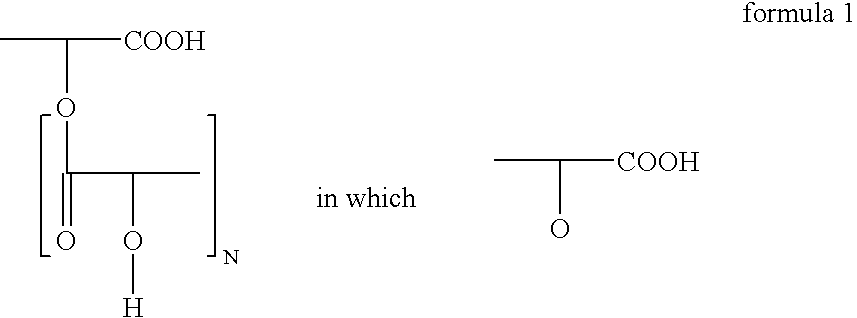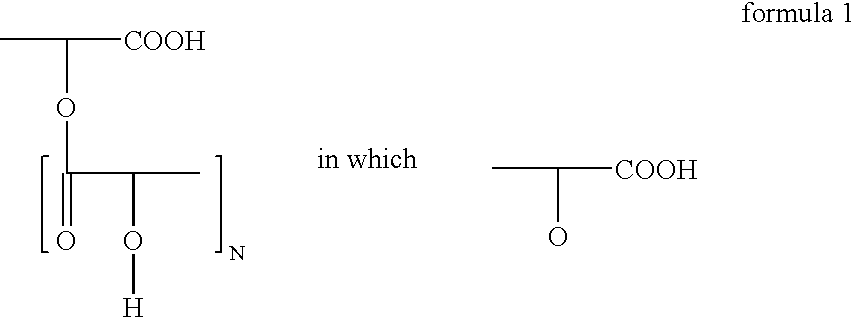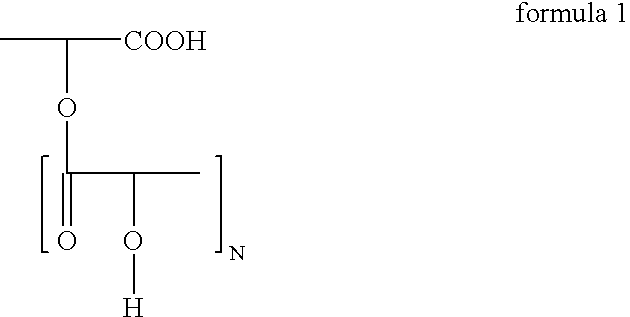Polyglycerol partial esters of polyricinoleic acid and polyfunctional carboxylic acids and the use thereof for producing emulsions and dispersions
a technology of polyricinoleic acid and polyfunctional carboxylic acids, which is applied in the direction of fatty acid chemical modification, chemical/physical processes, fatty oil/fat refining, etc., can solve the problems of difficult stabilization of water-in-oil emulsions, adverse skin feel, high viscosity oils and stabilizing waxes, etc., to achieve reduced viscosity, light skin feel, and oxidation resistance. , the effect o
- Summary
- Abstract
- Description
- Claims
- Application Information
AI Technical Summary
Benefits of technology
Problems solved by technology
Method used
Image
Examples
synthesis examples
EXAMPLE 1
[0139] The polyglycerol ester was prepared in 2 stages, which proceed in a manner known per se. Firstly, polyglycerol was esterified with fatty acid. 94.8 g (0.33 mol) of isostearic acid and 17.4 g (0.086 mol) of sebacic acid were esterified with 67.6 g of polyglycerol in the first stage at 240° C. while passing nitrogen through. The polyglycerol was characterized by its hydroxyl number of 1080. After a reaction time of 2 hours at this temperature, the acid number was <10. Then, at 240° C., 120 g of polyricinoleic acid were added while passing nitrogen through. The polyricinoleic acid was characterized by its acid number. It was between 100 and 30, preferably between 60 and 40. The mixture was then stirred at 240° C. until the AN was <5.
example 2
[0140] The polyglycerol ester was prepared in 2 stages, which proceed in a manner known per se. Firstly, polyglycerol was esterified with fatty acid. 103.8 g (0.36 mol) of isostearic acid and 17.4 g (0.086 mol) of sebacic acid were esterified with 67.6 g of polyglycerol in the first stage at 240° C. while passing nitrogen through. The polyglycerol was characterized by its hydroxyl number of 1080. After a reaction time of 2 hours at this temperature, the acid number was <10. Then, at 240° C., 111 g of polyricinoleic acid were added while passing nitrogen through. The polyricinoleic acid was characterized by its acid number. It was between 100 and 30, preferably between 60 and 40. The mixture was then stirred at 240° C. until the AN was <5.
example 3
[0141] The polyglycerol ester was prepared in 2 stages, which proceed in a manner known per se. Firstly, polyglycerol was esterified with fatty acid. 94.8 g (0.33 mol) of isostearic acid and 17.4 g (0.086 mol) of sebacic acid were esterified with 67.6 g of polyglycerol in the first stage at 240° C. while passing nitrogen through. The polyglycerol was characterized by its hydroxyl number of 1080. After a reaction time of 2 hours at this temperature, the acid number was <10. Then, at 240° C., 96 g of polyricinoleic acid were added while passing nitrogen through. The polyricinoleic acid was characterized by its acid number. It was between 100 and 30, preferably between 60 and 40. The mixture was then stirred at 240° C. until the AN was <5.
PUM
| Property | Measurement | Unit |
|---|---|---|
| solidification points | aaaaa | aaaaa |
| diameter | aaaaa | aaaaa |
| diameter | aaaaa | aaaaa |
Abstract
Description
Claims
Application Information
 Login to View More
Login to View More - R&D
- Intellectual Property
- Life Sciences
- Materials
- Tech Scout
- Unparalleled Data Quality
- Higher Quality Content
- 60% Fewer Hallucinations
Browse by: Latest US Patents, China's latest patents, Technical Efficacy Thesaurus, Application Domain, Technology Topic, Popular Technical Reports.
© 2025 PatSnap. All rights reserved.Legal|Privacy policy|Modern Slavery Act Transparency Statement|Sitemap|About US| Contact US: help@patsnap.com



